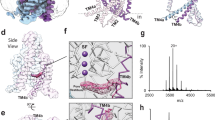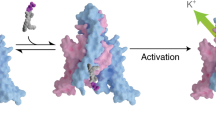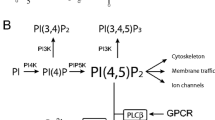Abstract
The background K+ channel TRESK regulates sensory neuron excitability, and changes in its function/expression contribute to neuronal hyperexcitability after injury/inflammation, making it an attractive therapeutic target for pain-related disorders. Factors that change lipid bilayer composition/properties (including volatile anesthetics, chloroform, chlorpromazine, shear stress, and cell swelling/shrinkage) modify TRESK current, but despite the importance of anionic phospholipids (e.g., PIP2) in the regulation of many ion channels, it remains unknown if membrane lipids affect TRESK function. We describe that both human and rat TRESK contain potential anionic phospholipid binding sites (apbs) in the large cytoplasmic loop, but only the human channel is able to bind to multilamellar vesicles (MLVs), enriched with anionic phospholipids, suggesting an electrostatically mediated interaction. We mapped the apbs to a short stretch of 14 amino acids in the loop, located at the membrane-cytosol interface. Disruption of electrostatic lipid-TRESK interactions inhibited hTRESK currents, while subsequent application of Folch Fraction MLVs or a PIP2 analog activated hTRESK, an effect that was absent in the rat ortholog. Strikingly, channel activation by anionic phospholipids was conferred to rTRESK by replacing the equivalent rat sequence with the human apbs. Finally, in the presence of a calcineurin inhibitor, stimulation of a Gq/11-linked GPCR reduced hTRESK current, revealing a likely inhibitory effect of membrane lipid hydrolysis on hTRESK activity. This novel regulation of hTRESK by anionic phospholipids is a characteristic of the human channel that is not present in rodent orthologs. This must be considered when extrapolating results from animal models and may open the door to the development of novel channel modulators as analgesics.







Similar content being viewed by others
References
Goldstein SAN, Bayliss DA, Kim D et al (2005) International Union of Pharmacology. LV. Nomenclature and molecular relationships of two-P potassium channels. Pharmacol Rev 57:527–540. https://doi.org/10.1124/pr.57.4.12
Doyle DA, Morais Cabral J, Pfuetzner RA et al (1998) The structure of the potassium channel: molecular basis of K+ conduction and selectivity. Science 280:69–77
Enyedi P, Czirják G (2010) Molecular background of leak K+ currents: two-pore domain potassium channels. Physiol Rev 90:559–605. https://doi.org/10.1152/physrev.00029.2009
Bandulik S, Tauber P, Lalli E et al (2015) Two-pore domain potassium channels in the adrenal cortex. Pflugers Arch 467:1027–1042. https://doi.org/10.1007/s00424-014-1628-6
Duprat F, Lauritzen I, Patel A, Honoré E (2007) The TASK background K2P channels: chemo- and nutrient sensors. Trends Neurosci 30:573–580. https://doi.org/10.1016/j.tins.2007.08.003
Mathie A, Veale EL (2015) Two-pore domain potassium channels: potential therapeutic targets for the treatment of pain. Pflugers Arch 467:931–943. https://doi.org/10.1007/s00424-014-1655-3
Steinberg EA, Wafford KA, Brickley SG et al (2014) The role of K2P channels in anaesthesia and sleep. Pflugers Arch 467:907–916. https://doi.org/10.1007/s00424-014-1654-4
Sano Y, Inamura K, Miyake A et al (2003) A novel two-pore domain K+ channel, TRESK, is localized in the spinal cord. J Biol Chem 278:27406–27412
Bautista DM, Sigal YM, Milstein AD et al (2008) Pungent agents from Szechuan peppers excite sensory neurons by inhibiting two-pore potassium channels. Nat Neurosci 11:772–779. https://doi.org/10.1038/nn.2143
Tulleuda A, Cokic B, Callejo G et al (2011) TRESK channel contribution to nociceptive sensory neurons excitability: modulation by nerve injury. Mol Pain 7:30. https://doi.org/10.1186/1744-8069-7-30
Dobler T, Springauf A, Tovornik S et al (2007) TRESK two-pore-domain K+ channels constitute a significant component of background potassium currents in murine dorsal root ganglion neurones. J Physiol Lond 585:867–879. https://doi.org/10.1113/jphysiol.2007.145649
Usoskin D, Furlan A, Islam S et al (2015) Unbiased classification of sensory neuron types by large-scale single-cell RNA sequencing. Nat Neurosci 18:145–153. https://doi.org/10.1038/nn.3881
Chiu IM, Barrett LB, Williams EK et al (2014) Transcriptional profiling at whole population and single cell levels reveals somatosensory neuron molecular diversity. Elife. https://doi.org/10.7554/eLife.04660
Manteniotis S, Lehmann R, Flegel C et al (2013) Comprehensive RNA-Seq expression analysis of sensory ganglia with a focus on ion channels and GPCRs in trigeminal ganglia. PLoS One 8:e79523. https://doi.org/10.1371/journal.pone.0079523
Kang D, Kim D (2006) TREK-2 (K2P10.1) and TRESK (K2P18.1) are major background K+ channels in dorsal root ganglion neurons. Am J Physiol, Cell Physiol 291:C138–C146. https://doi.org/10.1152/ajpcell.00629.2005
Lennertz RC, Tsunozaki M, Bautista DM, Stucky CL (2010) Physiological basis of tingling paresthesia evoked by hydroxy-sanshool. J Neurosci 30:4353–4361. https://doi.org/10.1523/JNEUROSCI.4666-09.2010
Castellanos A, Andres A, Bernal L et al (2018) Pyrethroids inhibit K2P channels and activate sensory neurons. Pain 159:92–105. https://doi.org/10.1097/j.pain.0000000000001068
Lafrenière RG, Cader MZ, Poulin J-F et al (2010) A dominant-negative mutation in the TRESK potassium channel is linked to familial migraine with aura. Nat Med 16:1157–1160. https://doi.org/10.1038/nm.2216
Liu P, Xiao Z, Ren F et al (2013) Functional analysis of a migraine-associated TRESK K+ channel mutation. J Neurosci 33:12810–12824. https://doi.org/10.1523/JNEUROSCI.1237-13.2013
Zhou J, Chen H, Yang C et al (2017) Reversal of TRESK downregulation alleviates neuropathic pain by inhibiting activation of gliocytes in the spinal cord. Neurochem Res 42:1288–1298. https://doi.org/10.1007/s11064-016-2170-z
Callejo G, Giblin JP, Gasull X (2013) Modulation of TRESK background K+ channel by membrane stretch. PLoS One 8:e64471. https://doi.org/10.1371/journal.pone.0064471
Guo Z, Cao Y-Q (2014) Over-expression of TRESK K(+) channels reduces the excitability of trigeminal ganglion nociceptors. PLoS One 9:e87029. https://doi.org/10.1371/journal.pone.0087029
Zhou J, Yang C-X, Zhong J-Y, Wang H-B (2013) Intrathecal TRESK gene recombinant adenovirus attenuates spared nerve injury-induced neuropathic pain in rats. Neuroreport 24:131–136. https://doi.org/10.1097/WNR.0b013e32835d8431
Zhou J, Yao S-L, Yang C-X et al (2012) TRESK gene recombinant adenovirus vector inhibits capsaicin-mediated substance P release from cultured rat dorsal root ganglion neurons. Mol Med Report 5:1049–1052. https://doi.org/10.3892/mmr.2012.778
Liu C, Au JD, Zou HL et al (2004) Potent activation of the human tandem pore domain K channel TRESK with clinical concentrations of volatile anesthetics. Anesth Analg 99:1715–1722, table of contents. https://doi.org/10.1213/01.ANE.0000136849.07384.44
Sonner JM, Cantor RS (2013) Molecular mechanisms of drug action: an emerging view. Annu Rev Biophys 42:143–167. https://doi.org/10.1146/annurev-biophys-083012-130341
Czirják G, Tóth ZE, Enyedi P (2004) The two-pore domain K+ channel, TRESK, is activated by the cytoplasmic calcium signal through calcineurin. J Biol Chem 279:18550–18558. https://doi.org/10.1074/jbc.M312229200
Czirják G, Enyedi P (2006) Targeting of calcineurin to an NFAT-like docking site is required for the calcium-dependent activation of the background K+ channel, TRESK. J Biol Chem 281:14677–14682. https://doi.org/10.1074/jbc.M602495200
Kang D, Kim G-T, Kim E-J et al (2008) Lamotrigine inhibits TRESK regulated by G-protein coupled receptor agonists. Biochem Biophys Res Commun 367:609–615. https://doi.org/10.1016/j.bbrc.2008.01.008
Kollert S, Dombert B, Döring F, Wischmeyer E (2015) Activation of TRESK channels by the inflammatory mediator lysophosphatidic acid balances nociceptive signalling. Sci Rep 5:12548. https://doi.org/10.1038/srep12548
Hughes S, Marsh SJ, Tinker A, Brown DA (2007) PIP2-dependent inhibition of M-type (Kv7.2/7.3) potassium channels: direct on-line assessment of PIP2 depletion by Gq-coupled receptors in single living neurons. Pflugers Arch 455:115–124. https://doi.org/10.1007/s00424-007-0259-6
Li Y, Gamper N, Hilgemann DW, Shapiro MS (2005) Regulation of Kv7 (KCNQ) K+ channel open probability by phosphatidylinositol 4,5-bisphosphate. J Neurosci 25:9825–9835. https://doi.org/10.1523/JNEUROSCI.2597-05.2005
Willars GB, Nahorski SR, Challiss RA (1998) Differential regulation of muscarinic acetylcholine receptor-sensitive polyphosphoinositide pools and consequences for signaling in human neuroblastoma cells. J Biol Chem 273:5037–5046
Allen V, Swigart P, Cheung R et al (1997) Regulation of inositol lipid-specific phospholipase cdelta by changes in Ca2+ ion concentrations. Biochem J 327(Pt 2):545–552
Rohács T (2016) Phosphoinositide signaling in somatosensory neurons. Advances in Biological Regulation 61:2–16. https://doi.org/10.1016/j.jbior.2015.11.012
Hilgemann DW, Feng S, Nasuhoglu C (2001) The complex and intriguing lives of PIP2 with ion channels and transporters. Sci STKE 2001:re19. https://doi.org/10.1126/stke.2001.111.re19
Chemin J, Patel AJ, Duprat F et al (2005) A phospholipid sensor controls mechanogating of the K+ channel TREK-1. EMBO J 24:44–53. https://doi.org/10.1038/sj.emboj.7600494
Chemin J, Patel AJ, Duprat F et al (2007) Up- and down-regulation of the mechano-gated K(2P) channel TREK-1 by PIP (2) and other membrane phospholipids. Pflugers Arch 455:97–103. https://doi.org/10.1007/s00424-007-0250-2
Lopes CMB, Rohács T, Czirják G et al (2005) PIP2 hydrolysis underlies agonist-induced inhibition and regulates voltage gating of two-pore domain K+ channels. J Physiol Lond 564:117–129. https://doi.org/10.1113/jphysiol.2004.081935
Brzeska H, Guag J, Remmert K et al (2010) An experimentally based computer search identifies unstructured membrane-binding sites in proteins. J Biol Chem 285:5738–5747. https://doi.org/10.1074/jbc.M109.066910
Letunic I, Doerks T, Bork P (2014) SMART: recent updates, new developments and status in 2015. Nucleic Acids Res 43:D257–D260. https://doi.org/10.1093/nar/gku949
Schultz J, Milpetz F, Bork P, Ponting CP (1998) SMART, a simple modular architecture research tool: identification of signaling domains. Proc Natl Acad Sci U S A 95:5857–5864
Callejo G, Castellanos A, Castany M et al (2015) Acid-sensing ion channels detect moderate acidifications to induce ocular pain. Pain 156:483–495. https://doi.org/10.1097/01.j.pain.0000460335.49525.17
Lemmon MA (2008) Membrane recognition by phospholipid-binding domains. Nat Rev Mol Cell Biol 9:99–111. https://doi.org/10.1038/nrm2328
Hernandez CC, Zaika O, Shapiro MS (2008) A carboxy-terminal inter-helix linker as the site of phosphatidylinositol 4,5-bisphosphate action on Kv7 (M-type) K +channels. J Gen Physiol 132:361–381. https://doi.org/10.1085/jgp.200810007
Shyng SL, Cukras CA, Harwood J, Nichols CG (2000) Structural determinants of PIP(2) regulation of inward rectifier K(ATP) channels. J Gen Physiol 116:599–608
Zeng W-Z, Liou H-H, Krishna UM et al (2002) Structural determinants and specificities for ROMK1-phosphoinositide interaction. American Journal of Physiology- Renal Physiology 282:F826–F834. https://doi.org/10.1152/ajprenal.00300.2001
Zhang H, He C, Yan X et al (1999) Activation of inwardly rectifying K+ channels by distinct PtdIns(4,5)P2 interactions. Nat Cell Biol 1:183–188. https://doi.org/10.1038/11103
Folch J (1942) Brain cephalin, a mixture of phosphatides. Separation from it of phosphatidylserine, phosphatidylenthanolamine, and a fraction containing an inositol phosphatide. J Biol Chem 146:35–44
Kimelberg HK, Papahadjopoulos D (1971) Interactions of basic proteins with phospholipid membranes. Binding and changes in the sodium permeability of phosphatidylserine vesicles. J Biol Chem 246:1142–1148
Fan Z, Makielski JC (1997) Anionic phospholipids activate ATP-sensitive potassium channels. J Biol Chem 272:5388–5395
Huang CL, Feng S, Hilgemann DW (1998) Direct activation of inward rectifier potassium channels by PIP2 and its stabilization by Gbetagamma. Nature 391:803–806. https://doi.org/10.1038/35882
Lopes CMB, Zhang H, Rohács T et al (2002) Alterations in conserved Kir channel-PIP2 interactions underlie channelopathies. Neuron 34:933–944
Veldhuis NA, Poole DP, Grace M et al (2015) The G protein-coupled receptor-transient receptor potential channel axis: molecular insights for targeting disorders of sensation and inflammation. Pharmacol Rev 67:36–73. https://doi.org/10.1124/pr.114.009555
Sandoz G, Bell SC, Isacoff EY (2011) Optical probing of a dynamic membrane interaction that regulates the TREK1 channel. Proc Natl Acad Sci U S A 108:2605–2610. https://doi.org/10.1073/pnas.1015788108
Rayaprolu V, Royal P, Stengel K et al (2018) Dimerization of the voltage-sensing phosphatase controls its voltage-sensing and catalytic activity. J Gen Physiol 150:683–696. https://doi.org/10.1085/jgp.201812064
Stauffer TP, Ahn S, Meyer T (1998) Receptor-induced transient reduction in plasma membrane PtdIns(4,5)P2 concentration monitored in living cells. Curr Biol 8:343–346
Falkenburger BH, Jensen JB, Dickson EJ et al (2010) Phosphoinositides: lipid regulators of membrane proteins. J Physiol Lond 588:3179–3185. https://doi.org/10.1113/jphysiol.2010.192153
Gamper N, Shapiro MS (2007) Regulation of ion transport proteins by membrane phosphoinositides. Nat Rev Neurosci 8:921–934. https://doi.org/10.1038/nrn2257
Braun G, Nemcsics B, Enyedi P, Czirják G (2011) TRESK background K(+) channel is inhibited by PAR-1/MARK microtubule affinity-regulating kinases in Xenopus oocytes. PLoS One 6:e28119. https://doi.org/10.1371/journal.pone.0028119
Chemin J, Girard C, Duprat F et al (2003) Mechanisms underlying excitatory effects of group I metabotropic glutamate receptors via inhibition of 2P domain K+ channels. EMBO J 22:5403–5411. https://doi.org/10.1093/emboj/cdg528
Lesage F, Terrenoire C, Romey G, Lazdunski M (2000) Human TREK2, a 2P domain mechano-sensitive K+ channel with multiple regulations by polyunsaturated fatty acids, lysophospholipids, and Gs, Gi, and Gq protein-coupled receptors. J Biol Chem 275:28398–28405
Czirják G, Enyedi P (2010) TRESK background K(+) channel is inhibited by phosphorylation via two distinct pathways. J Biol Chem 285:14549–14557. https://doi.org/10.1074/jbc.M110.102020
Enyedi P, Veres I, Braun G, Czirják G (2014) Tubulin binds to the cytoplasmic loop of TRESK background K+ channel in vitro. PLoS One 9:e97854. https://doi.org/10.1371/journal.pone.0097854
Czirják G, Vuity D, Enyedi P (2008) Phosphorylation-dependent binding of 14-3-3 proteins controls TRESK regulation. J Biol Chem 283:15672–15680. https://doi.org/10.1074/jbc.M800712200
Hille B, Dickson EJ, Kruse M et al (2015) Phosphoinositides regulate ion channels. Biochimica et Biophysica Acta (BBA) - Molecular and Cell Biology of Lipids 1851:844–856. https://doi.org/10.1016/j.bbalip.2014.09.010
Maingret F, Patel AJ, Lesage F et al (2000) Lysophospholipids open the two-pore domain mechano-gated K(+) channels TREK-1 and TRAAK. J Biol Chem 275:10128–10133
Chemin J, Patel A, Duprat F et al (2005) Lysophosphatidic acid-operated K+ channels. J Biol Chem 280:4415–4421. https://doi.org/10.1074/jbc.M408246200
Comoglio Y, Levitz J, Kienzler MA et al (2014) Phospholipase D2 specifically regulates TREK potassium channels via direct interaction and local production of phosphatidic acid. Proc Natl Acad Sci U S A 201407160:13547–13552. https://doi.org/10.1073/pnas.1407160111
Basbaum AI, Bautista DM, Scherrer G, Julius D (2009) Cellular and molecular mechanisms of pain. Cell 139:267–284. https://doi.org/10.1016/j.cell.2009.09.028
Hucho T, Levine JD (2007) Signaling pathways in sensitization: toward a nociceptor cell biology. Neuron 55:365–376. https://doi.org/10.1016/j.neuron.2007.07.008
Keshavaprasad B, Liu C, Au JD et al (2005) Species-specific differences in response to anesthetics and other modulators by the K2P channel TRESK. Anesth Analg 101:1042–1049, table of contents. https://doi.org/10.1213/01.ane.0000168447.87557.5a
Czirják G, Enyedi P (2014) The LQLP Calcineurin-docking site is a major determinant of the calcium-dependent activation of human TRESK background K+ channel. J Biol Chem 289:29506–29518. https://doi.org/10.1074/jbc.M114.577684
Czirják G, Enyedi P (2006) Zinc and mercuric ions distinguish TRESK from the other two-pore-domain K+ channels. Mol Pharmacol 69:1024–1032. https://doi.org/10.1124/mol.105.018556
Marsh B, Acosta C, Djouhri L, Lawson SN (2012) Leak K+ channel mRNAs in dorsal root ganglia: relation to inflammation and spontaneous pain behaviour. Mol Cell Neurosci 49:375–386. https://doi.org/10.1016/j.mcn.2012.01.002
Funding
Supported by grants from Ministerio de Economia y Competitividad and Instituto de Salud Carlos III of Spain FIS PI14/00141 (XG) and FIS PI17/00296 (XG), RETICs Oftared RD12/0034/0003 (XG) and RD16/0008/0014 (XG), and Generalitat de Catalunya 2014SGR1165 (XG) and 2017SGR737 (XG). J.P.G. was supported by a Ramón y Cajal Research Contract (Ministerio de Economia y Competitividad RYC-2011-08589).
Author information
Authors and Affiliations
Contributions
Authors JPG, AC, and AA carried out cellular cultures, plasmid generation, and transfection. JPG and IE performed construction of GST fusion proteins, chimeric constructs, and liposome binding assays. AC, AA, and XG performed electrophysiological recordings in cell lines. JPG and XG participated in the design of the study and performed the statistical analysis. JPG and XG conceived the study, oversaw the research, and prepared the manuscript with help from all others. All authors read and approved the final manuscript.
Corresponding author
Ethics declarations
Conflict of Interest
The authors declare no competing financial interests
Electronic Supplementary Material
ESM 1
(DOCX 65 kb)
Rights and permissions
About this article
Cite this article
Giblin, J.P., Etayo, I., Castellanos, A. et al. Anionic Phospholipids Bind to and Modulate the Activity of Human TRESK Background K+ Channel. Mol Neurobiol 56, 2524–2541 (2019). https://doi.org/10.1007/s12035-018-1244-0
Received:
Accepted:
Published:
Issue Date:
DOI: https://doi.org/10.1007/s12035-018-1244-0




